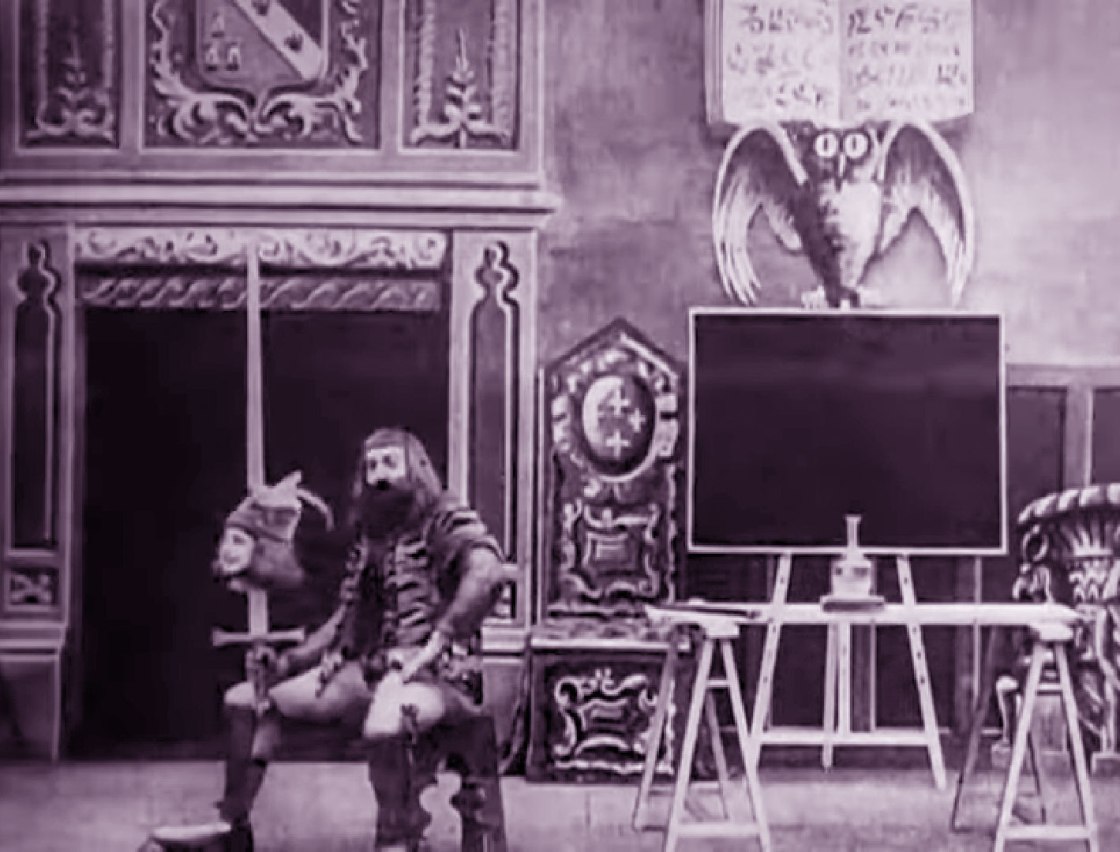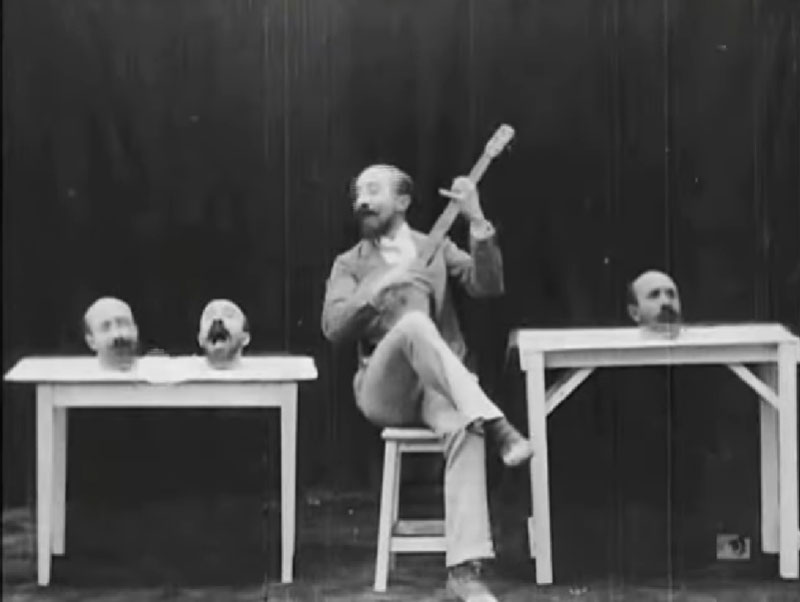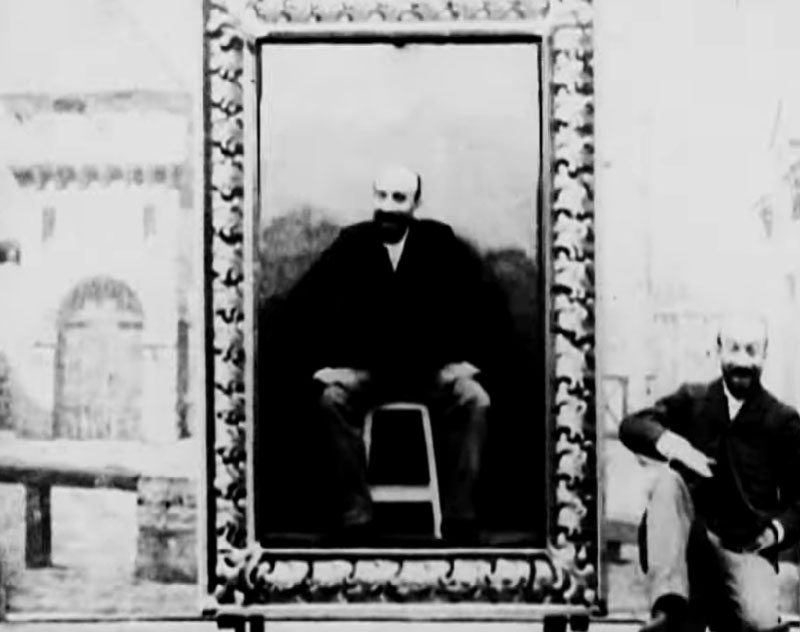Georges Méliès serves up a medieval fantasy, playing a chalk-wielding alchemist who has a little too much fun with the severed head he conjures via blackboard.
Home Media Availability: Released on DVD by Flicker Alley.
Alas, poor chalk head
Georges Méliès had been among the very first producers of motion pictures, entering the film industry in 1896, its first full year of projected cinema. He released adaptations of stage magic tricks along with actualities (documentary footage sans narrative) and reenactments of major news events. In short, the typical output of an 1890s studio.
1899 had been a turning point for Méliès. He released his first multi-scene picture, an ambitious adaptation of Cinderella with lavish hand-applied color and a memorable sequence in which the heroine is tormented by animated double exposure clocks. Méliès’ other major release was a multi-part film reenacting major events in the scandalous Dreyfus Affair.
If you are unfamiliar with the event, a Jewish officer in the French army was framed for espionage and exiled to Devil’s Island. Authorities refused to release him and initiated a coverup to avoid embarrassment. French society was divided between those who thought Dreyfus innocent or guilty with antisemitism playing strongly into the anti-Dreyfus camp. Méliès was firmly on the side of Dreyfus and the film was passionately sympathetic to his plight. (I reviewed the film and delved into Dreyfus on screen in my review.)
After releasing two ambitious productions, Méliès seemed to take a bit of a breather and returned to the magic and actualities that he had been producing so successfully and The Mysterious Knight is a release from this period.
The Mysterious Knight covers familiar ground in the Méliès canon. The director plays a medieval conjurer, complete with tights and a long wig. He draws a page’s head on a blackboard—never mind that those were an eighteenth-century innovation, whose fantasy is this anyway? He reaches out and pulls the drawing away from the blackboard and, abracadabra, it becomes a real head. The conjurer places the head on a vase, runs a sword through it, puts it atop a tripod.
The whole time, the head converses with the conjurer via substitution splice, replacing the fake head for that of a performer. The actress would have been draped in black from the neck down, creating the effect of a severed head.
However, what’s the point of featuring a lovely young lady if all we see is her head? That simply wasn’t the Méliès way, so he conjures a body for the page’s head before waving away the entire form with a fan. He makes the page reappear and then removes the head and tosses it back onto the blackboard, creating a symmetrical end to the fantasy.
Anyone familiar with Méliès’ work from this period will probably recognize themes that have appeared numerous times in his earlier films. The Vanishing Lady (1896) featured a woman appearing and disappearing at the whim of a magician (or so he thinks), and The Four Troublesome Heads (1898) featured Méliès dealing with a three-man chorus made up of clones of his own head before he smashes two of the heads with a banjo, tears off how own and attaches the third to his neck. (The concept of violently destroying a clone was explored in more depth in the Jean Durand-Ernest Bourbon comedy Onesime vs Onesime a decade later.)
A Mysterious Portrait, in addition to sharing a similar title to The Mysterious Knight, shows Méliès summoning a work of art—an oil self-portrait in this case—and interacting with it before willing it out of existence. It lacks the violent end of The Four Troublesome Heads, the self-portrait merely shimmers away.
Both A Mysterious Portrait and The Four Troublesome Heads involve Méliès duplicating an aspect of himself and then finding it annoying and destroying it. This would be sadly prescient as Méliès burned most of his own films twenty years later in a fit of frustration.
The Mysterious Knight is a gentler take on the theme as Méliès and the head seem to get along swimmingly and the page takes no offence as her head is displayed, tossed and impaled. She is a bit taken aback when she is fanned into oblivion but there seem to be no hard feelings when her head is removed and returned to the blackboard. (Méliès returned to the theme in its more violent form with the 1901 comedy The Man with the Rubber Head.)
Remakes, ripoffs and recurring themes were all heavily present in early film as the filmmakers attempted to figure out their new art. New innovations were intently studied and scrupulously copied but there was also a culture of one-upmanship as film companies raced to produce something new ad exciting for their audience. Ironically, this was often achieved through blatant copying but, as Méliès shows, it was also possible for a director to grow by returning to their own earlier material and remixing the themes.
The Mysterious Knight is also interesting because it showcases a different facet of Méliès as an artist. We tend to think of film history as a linear advancement but there have always been plenty of cases of artists deciding to take it easy after pouring their souls into something big. These films may not be particularly groundbreaking but there is something appealing about seeing a relaxed and polished production from an experienced artist.
The Mysterious Knight is a playful Méliès picture that also builds on the tricks and humor that he had been experimenting with since the beginning. It’s nothing new and never was expected to be but it’s fun to see our director and star wave his hands around the severed head with a “Look, ma, no strings” grin on his face. His enjoyment is as infectious as ever and further proves my point that Méliès’ success was due not only to his clever special effects but also his personal charisma on-camera.
It’s not A Trip to the Moon or The Dreyfus Affair but it’s a minute and a half of exuberant entertainment and I think I enjoyed it just as much as an audience of 1899 would have.
Where can I see it?
Released on DVD by Flickery Alley as part of their excellent Georges Méliès: The First Wizard of Cinema box set.
☙❦❧
Like what you’re reading? Please consider sponsoring me on Patreon. All patrons will get early previews of upcoming features, exclusive polls and other goodies.
Disclosure: Some links included in this post may be affiliate links to products sold by Amazon and as an Amazon Associate I earn from qualifying purchases.







